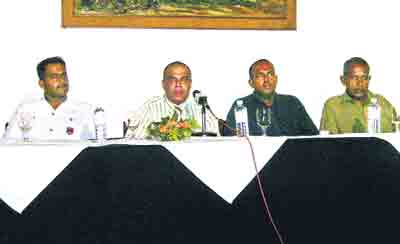
'Deep South' to rejuvenate flagging tourism
Hambantota -- The South of Sri Lanka has been one of the key destinations visited by tourists both foreign and local in the past. However, terrorist attacks in the Buttala and Thanamalvilla areas coupled with the threat of the LTTE in the Yala National Park-one of the chief attractions of the region- has crippled the industry in the past two to three years. The Hambantota District Chamber of Commerce (HDCC) has been making an attempt to amend the situation through a widespread programme which promotes the district as the "Deep South" of the Sri Lanka. Chamber Director General Azmi Thassim speaking to the media during a recent media tour of the Deep South was adamant on the success of the project. "We are the first district chamber which has taken the initiative to promote the destination and not individual hotels," he said, going on to say that the HDCC has been doing this at a number of travel fairs including two World Trade Markets. Tourism in the district is sporadic and varied. The shoreline-the longest in Sri Lanka- stretches from the main seaside towns of Ambalantota to Tissamaharama. While areas like Bentota, Beruwela and Hikkaduwa enjoy the patronage of local and foreign holiday makers on a regular basis, the inner areas of Tangalle, Hambantota town, Tissa and Kirinda have been staggering under the pressure to survive.
The HDCC has picked out "12 things you shouldn't miss in the Deep South", a comprehensive set of destinations that combine the heritage of the area as well as the adventure and nature tourism aspects. The measures are badly needed. President of the Tangalle Hoteliers Association K. Wedarachchi said that in the past, the 15-20 km shore stretch of Tangalle had enjoyed a steady trickle of back packer-type foreign tourists. "They spent a lot in the area and all the small-time vendors benefited. We hardly had any package tours," he said. The clientele was mainly British. Now, according to him, only close to 10 tourists can be found for 8-10 km of shoreline, and most of the operations have closed down. There is reason to believe that this may be due to the fact that there are only five Tourist-Board approved hotels in the stretch and also because the proprietors find it difficult to obtain liquor permits due to various issues including the high price attached to them, he said. The end situation is that in Tangalle, which is famed to be one of the most attractive beach fronts in the country, 90% of the hotels and guest houses have been closed down. The Tourist Traders Association of Tissa also expressed the same feelings. Head of the Association, Priyankara Wickremesekera, who also owns Hotel Priyankara in Tissa, said that occupancy rates in the area as well as his hotel had fallen from an average of 60% during the season to less that 30% in the past few months. The general complain of the officials in the tourist trade here is that the "Trouble in Yala" tag is attached to terrorist attacks in any part of the vast area that Yala sprawls over. Tourists are only taken to Block A, while the attacks happen primarily in the other three blocks. This has resulted in a number of foreign travel advisories that specifically mention the park as a no-go destination. As many of the tourists come in specifically to Yala, this has affected the whole area. The other industries in the area are faring better. While 10% of the 525,000 population depend on tourism, the fishing industry is one of the major livelihoods as well. |
|
||||||
|
||||||
| || Front
Page | News
| Editorial
| Columns
| Sports
| Plus
| Financial
Times | International
| Mirror
| TV
Times | Funday Times || |
| |
Reproduction of articles permitted when used without any alterations to contents and a link to the source page.
|
© Copyright
2008 | Wijeya
Newspapers Ltd.Colombo. Sri Lanka. All Rights Reserved. |

